Welcome back to Darryl’s Discoveries, where I search out the rarest and most beautiful specimens from our network of independent nurseries and specialty growers to find exotic plants and trees that are sure to impress even the most ardent of collectors. You have to act fast though because these plants are only available in extremely small quantities. Once they are sold out, it could be a while before we see them again.
Keep on planting,
-Darryl
Please Note that these plants were previously featured on Darryl’s Discoveries and may no longer be in stock. To see Darryl’s latest Discoveries, CLICK HERE. Want early access to PlantVine promotions like Darryl’s Discoveries, Luis’ Picks and more? Subscribe to our newsletter to receive emails that let you shop these specials before they go on sale to the public.
Heliconia psittacorum ‘Lady Di Variegata’
Heliconia psittacorum ‘Lady Di Variegata’
Sometimes call False Bird of Paradise because of the blossoms of the orange varieties, Heliconia Psittacorums actually come in a variety of colors, including this red and cream Lady Di. The green form of this plant is readily available, but it’s difficult to find mature specimens of the variegated form. This plant will add a touch of the tropics to your garden with its exotic blossoms and lush foliage. I have 5 available that are 3.5ft to 4ft tall in 10” pots.
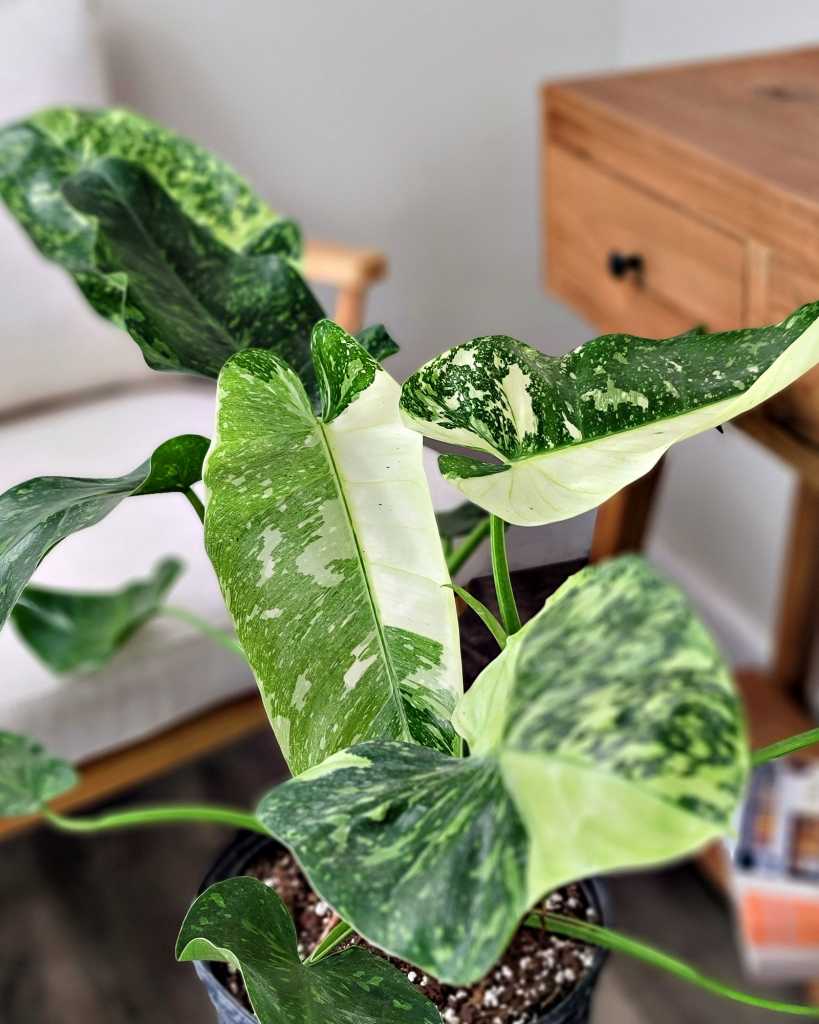
Philodendron ‘Jose Buono’
Philodendron ‘Jose Buono’
This is an incredible, variegated philodendron with large leaves and heavy variegation. The thick leaves can get up to 2 feet long and are covered with varying degrees of variegation, from white specs to half leaf to full on white. The white variegation contrasts nicely against the dark green foliage making this an attractive, eye-catching plant. It can be grown outdoors in warmer climates where it can get quite large, or indoors where it stays smaller. They’re 4.5ft to 5ft tall with leaves that are close to 2ft long in 12” pots.
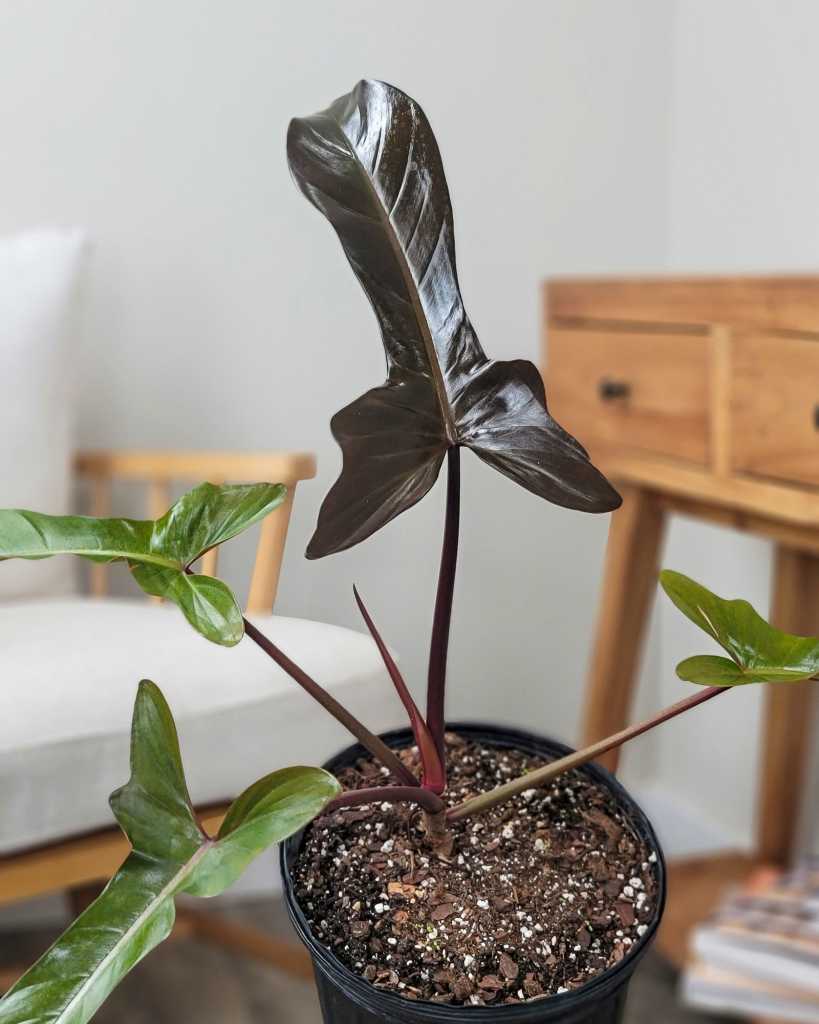
Philodendron ‘Florida Bronze’
Philodendron ‘Florida Bronze’
Super Rare & Big Plant Alert!! We all know Philodendron Florida Ghost and Florida Beauty. But did you know about the ultra rare Florida Bronze? This cross between Philodendron Florida and Black Cardinal grows new leaves which are bronze and glossy. Stems are bright red topped with sword-like leaves. This is a very unique plant, and is rarely, if ever, sold at this size.
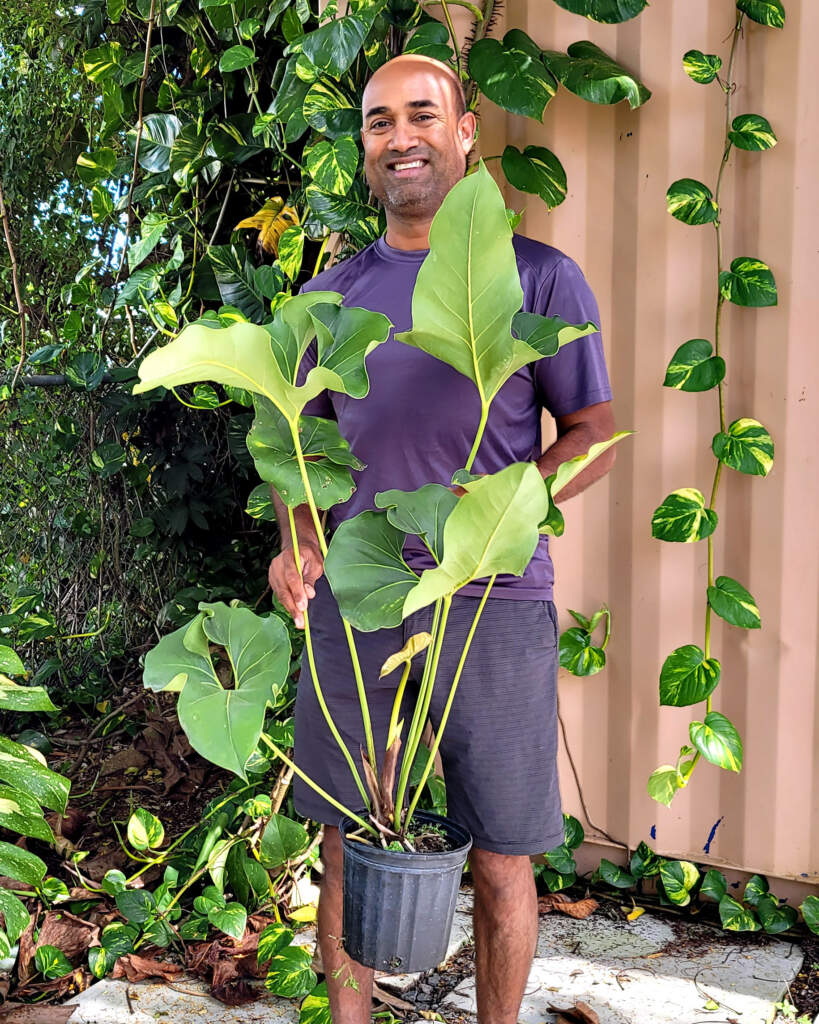
Anthurium brownii
Anthurium brownii
This anthurium is sure to be a centerpiece wherever you put it. A hard-to-get plant, Anthurium Brownii is pursued for its heart-shaped rippled leaves in which the lobes tend to fold back over each other. They are dark green with cream-colored veins. It is an easy to grow Anthurium whose unique leaves can get up to 24” long! It is such a unique and unusual anthurium which stands out from the pack.
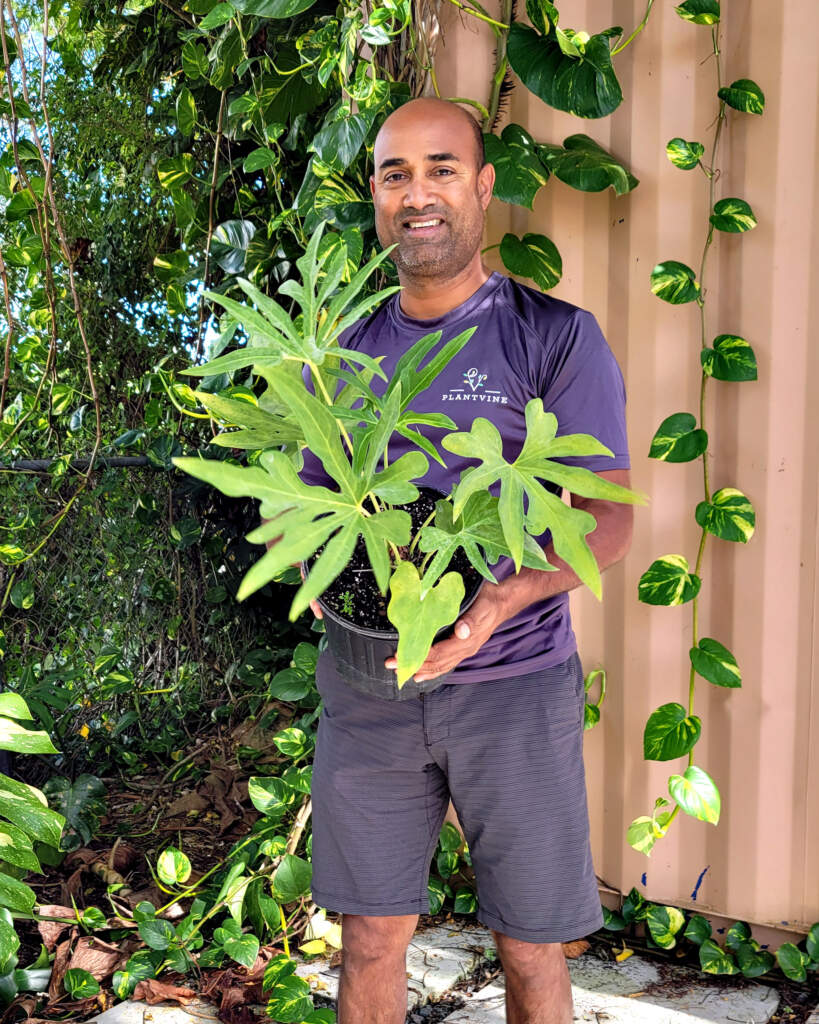
Anthurium podophyllum
Anthurium podophyllum
This unique anthurium from the tropical jungles along the Mexican East coast has lacy, deeply lobed leaves on its long petioles. The thick leaves can get up quite large, up to 3 feet long, making it one of the larger Anthuriums out there. It is easy to grow and loves to climb, so a totem or trellis would be help it reach its full potential. This is a rare aroid which is sought after by collectors.
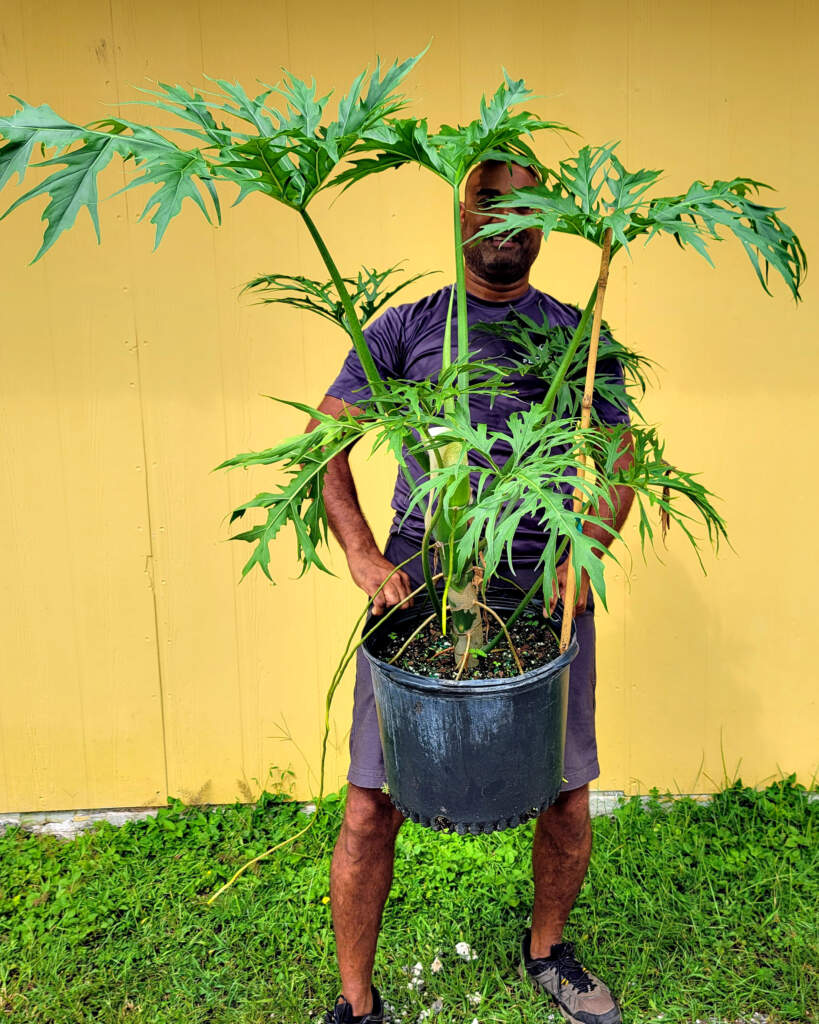
Philodendron warscewiczii
Philodendron warscewiczii
This lacy philodendron is native to the tropical jungles of southern Mexico and Central America. The plant has large divided leaves with a snowflake look, hence it’s common name, Snowflake Leaf Philodendron. The huge leaves are intricately shaped with lacey fingers and deep lobes. This Is a slow climbing philodendron which forms a heavy trunk and needs support as it matures for an upright shape. The thick stem of this philodendron will support its foliage up to 4ft. before requiring a supporting pole. It is low-maintenance and a hardy vining indoor plant.
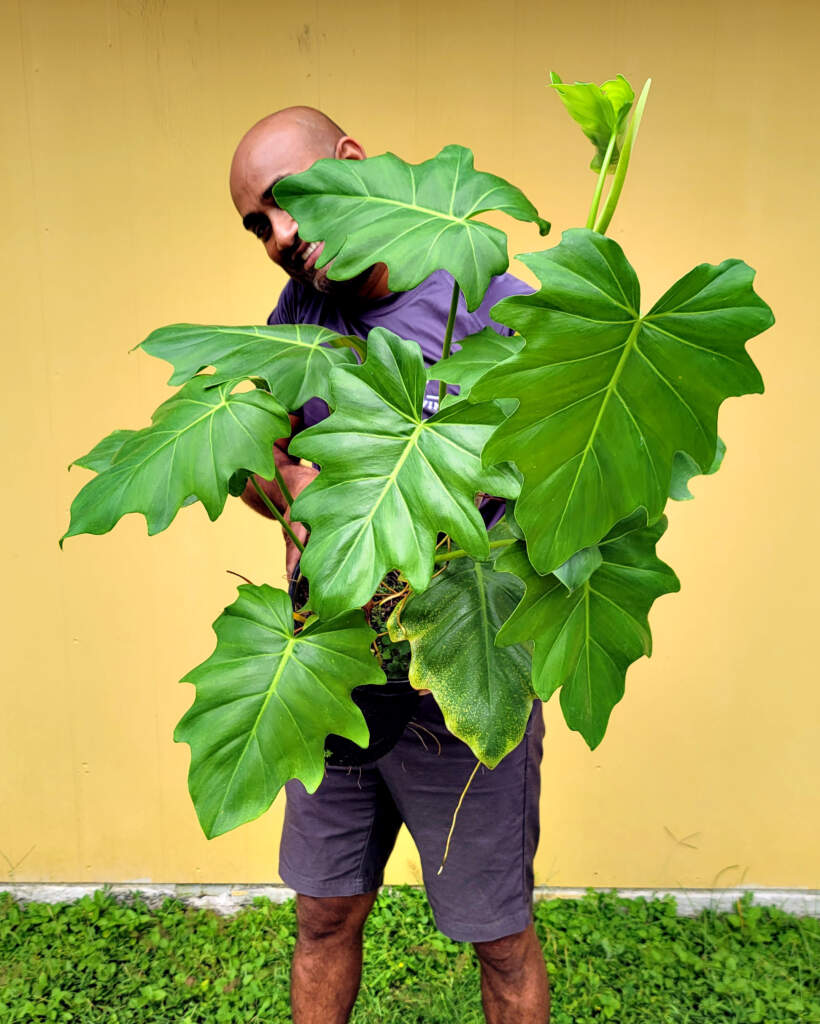
Philodendron radiatum
Philodendron radiatum
Philodendron Radiatum is a fast growing, climbing plant which needs a stake or totem pole to attach to. The leaves are dark glossy green and are medium-sized, about 1 to 2 feet. In its natural habitat of Central and South America, the aerial roots were used by indigenous peoples to weave baskets.
This is an easy to care for, vigorous plant which gives an instant tropical vibe.
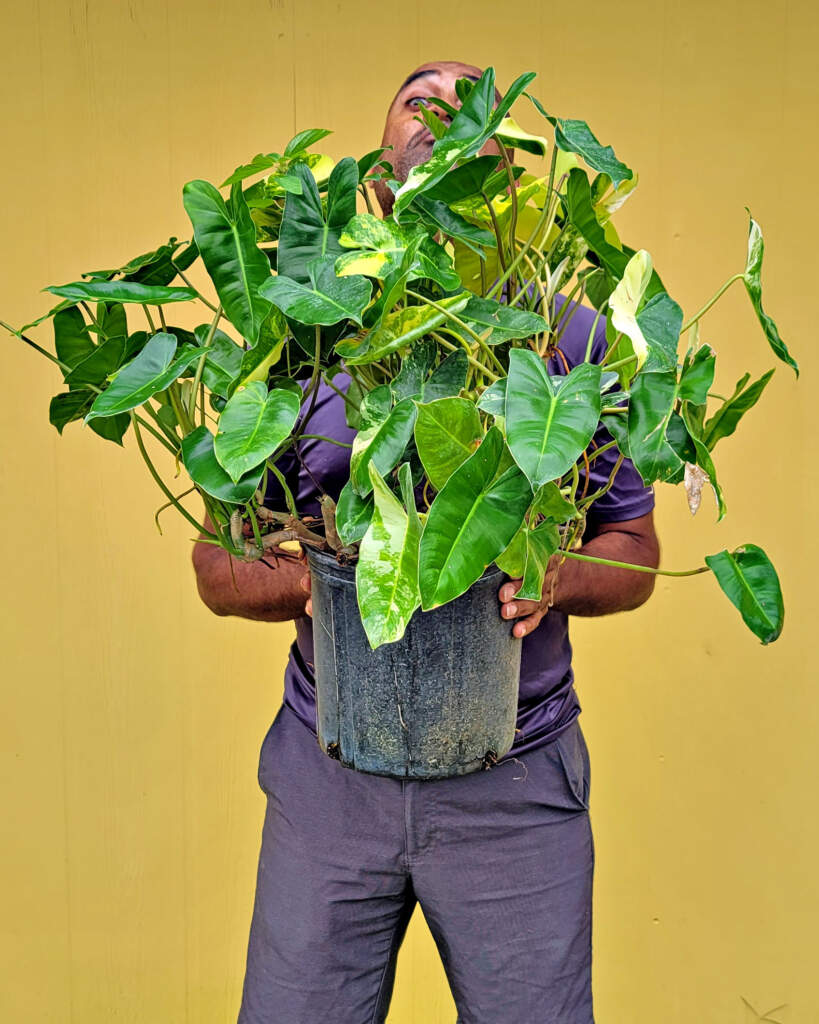
Philodendron ‘Variegated Burle Marx’
Philodendron ‘Variegated Burle Marx’
Look at how big and bushy these variegated Burle Marx Philodendrons are! Glossy, heart-shaped leaves are the focal point of this low profile Philodendron; but the awesome variegation makes them even better. A highly successful ground cover or border plant, the Burle Marx is also one of the easiest to grow indoor plants. This plant was named in honor of the brilliant Brazilian artist and landscape architect, Roberto Burle Marx.
These bushy and full specimens are about 2 feet tall in 10” pots, ready to be propagated.
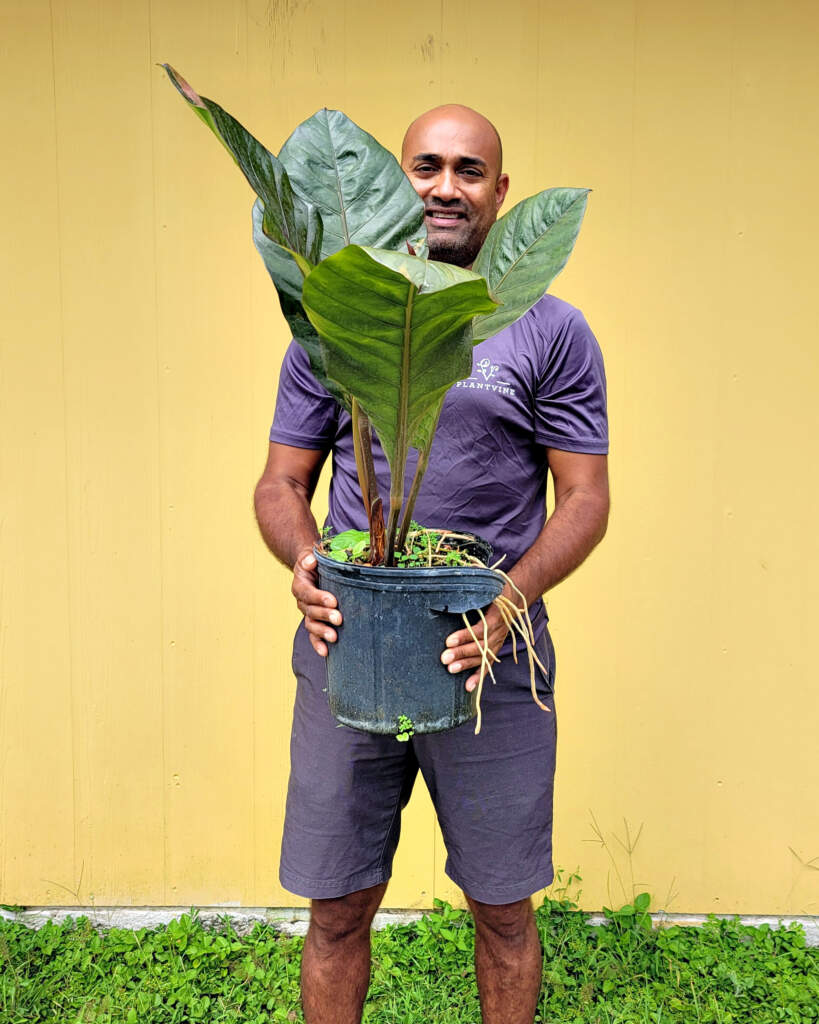
Anthurium ‘Thai Ruby’
Anthurium ‘Thai Ruby’
This rare variegated anthurium hybrid from Thailand is so gorgeous. The wide leaves of these plants can come in varying degrees of greens, whites and even reds. This particular specimen has tones of red and cream. When you find these plants for sale they’re usually pretty small – this one is about 32” tall in a 10” pot. The pictures don’t do this plant justice!
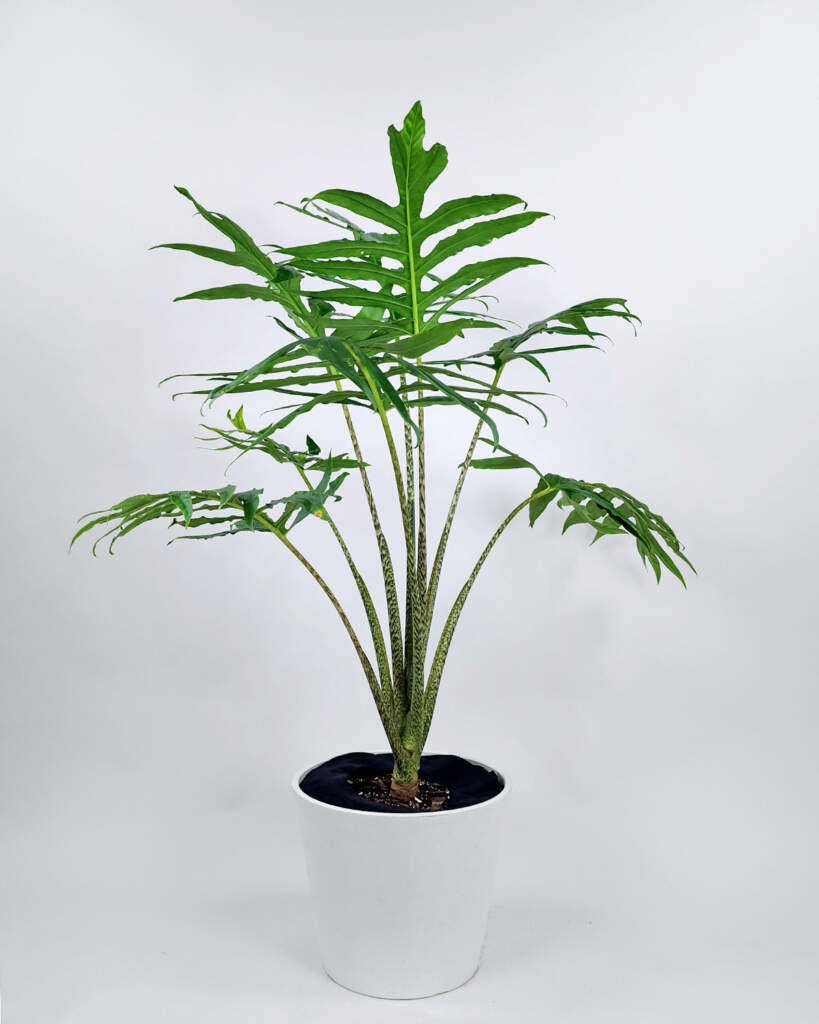
Alocasia ‘Serpent’s Tail’
Alocasia ‘Serpent’s Tail’
Alocasia Serpent’s Tail is a very rare, tropical plant that’s native to Southeast Asia. It’s known for its incredible, distinctive foliage which point upward and outward. The deeply-lobed leaves almost look more like a philodendron than an alocasia with their fishbone appearance. But it’s not just the leaves that are impressive – the speckled stem are beautiful, resembling those of alocasia zebrina.
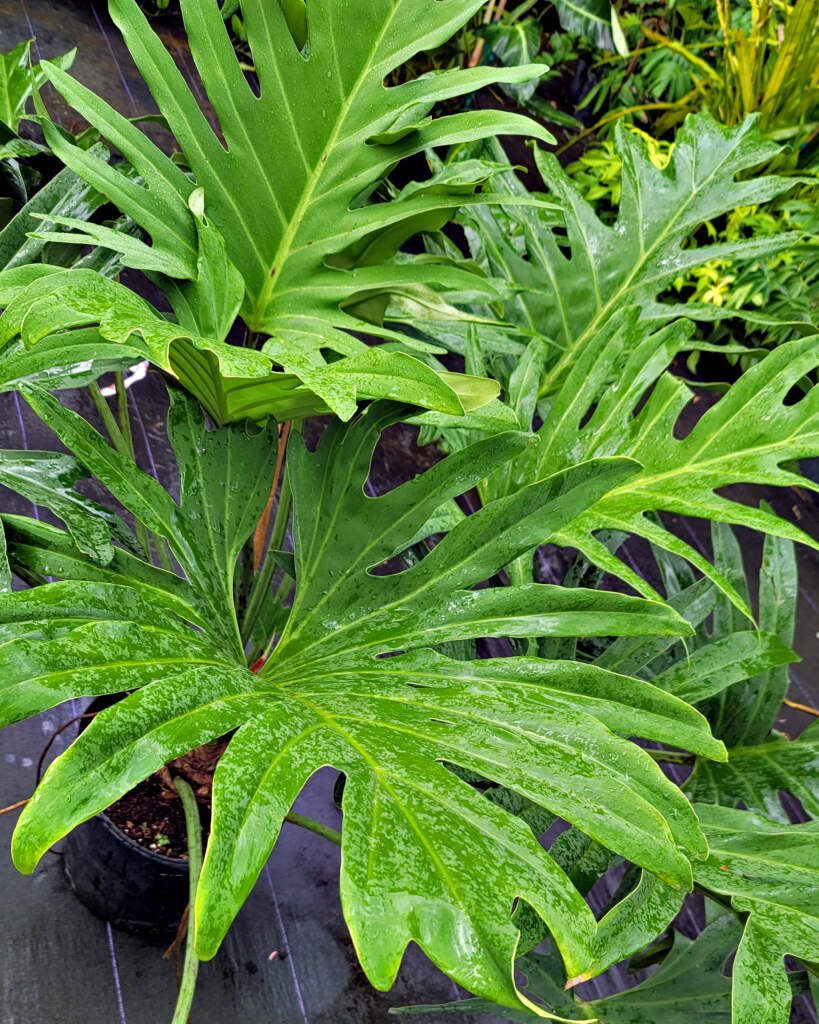
Philodendron pinnatifidum
Philodendron pinnatifidum
The Comb-Leaf Philodendron (as it’s commonly called) is a tropical plant that can grow up to 6 feet tall and just as wide. It has large, matte green leaves that are divided and have up to 15 lobes. The leaves can be up to 4 feet long and 2 feet wide. The stems and base of the leaves are usually spotted with flecks of dark red.
It is native to Venezuela and northwestern Brazil and was once a popular landscape plant because of its self-heading nature. This means that instead of being an unweildly vining climber, it tends to grow upright in a clean, tree-like fashion.This is one of my all time favorite philodendrons but it has become very very difficult to find.
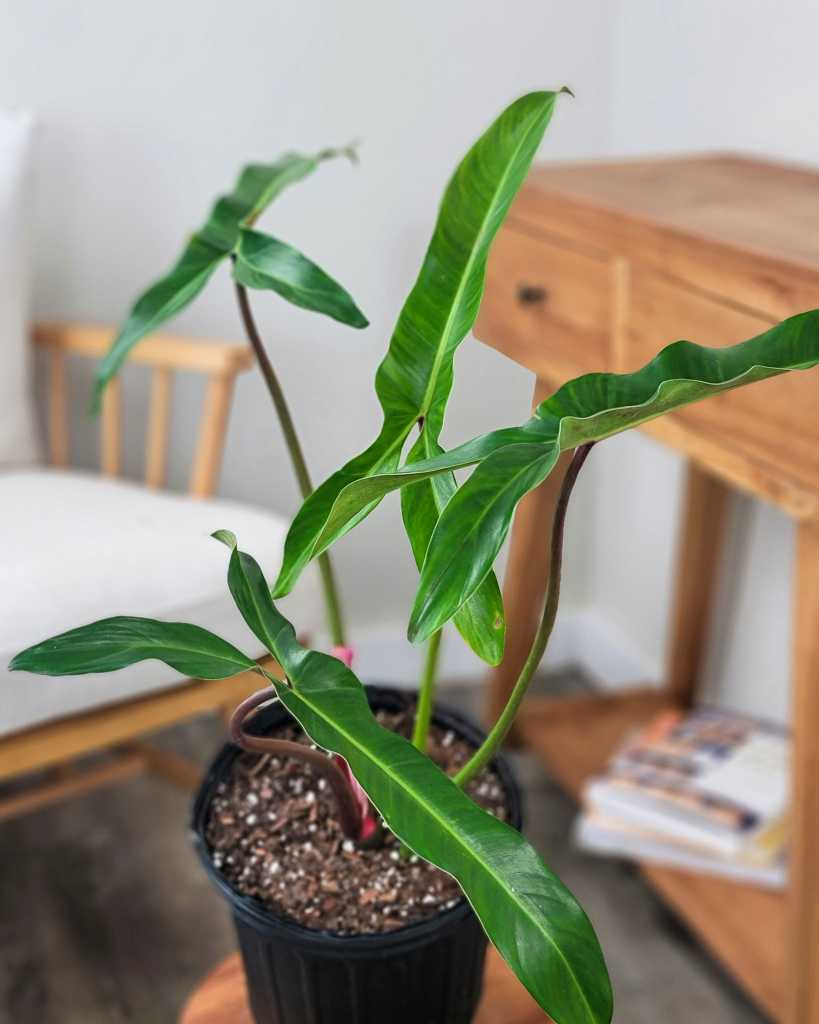
Mexican Philodendron
Philodendron mexicanum
This tri-lobed, strap leaf philodendron is a climber which grows fast. Its natural habitats are the rainforests of Mexico down to upper South America. The leaves have a distinctive deeply lobed shape and can get quite large, often up to 2 feet long, often resembling dog ears. This unusual and rare plant is must have for aroid enthusiasts or for anyone looking for a cool tropical plant.
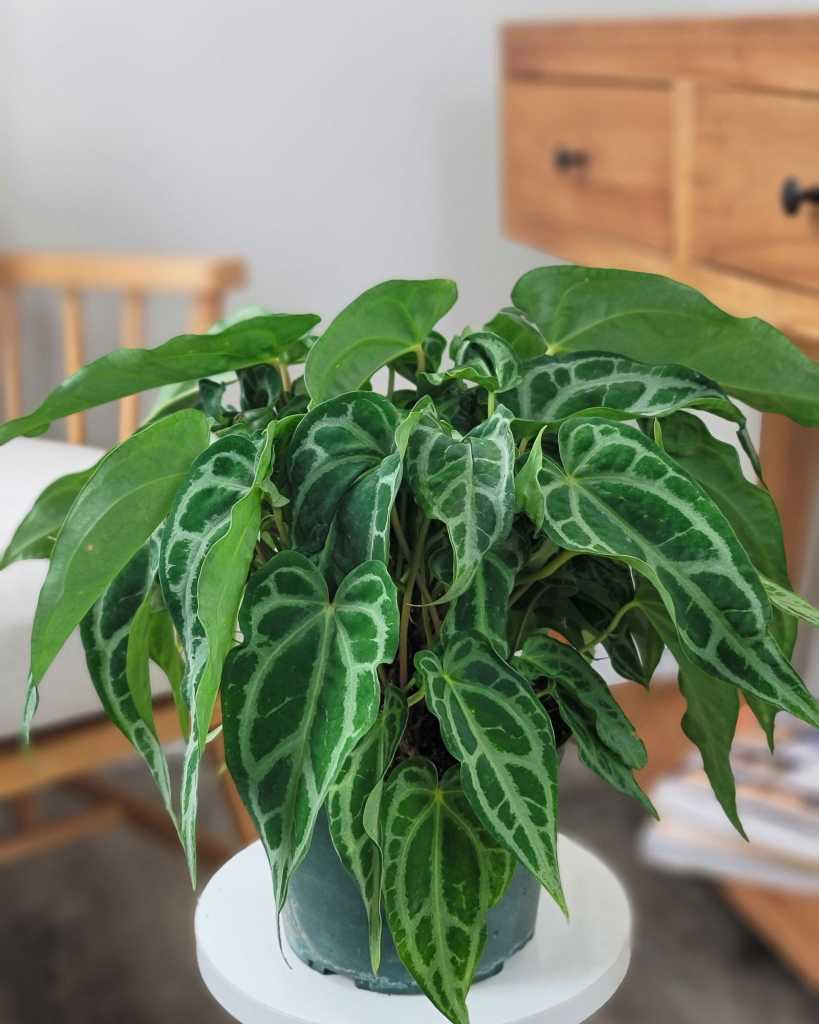
Anthurium ‘Selby’s Silver’
Anthurium ‘Selby’s Silver’
This is a true collector’s plant which are highly sought after, but extremely hard to find. Selby’s Silver Anthurium is even more beautiful than regular Crystallinum because of their more prominent silver veining. The new leaves of this diminutive crystallinum sport are usually purplish-burgundy adding interest and pop to an already beautiful plant.
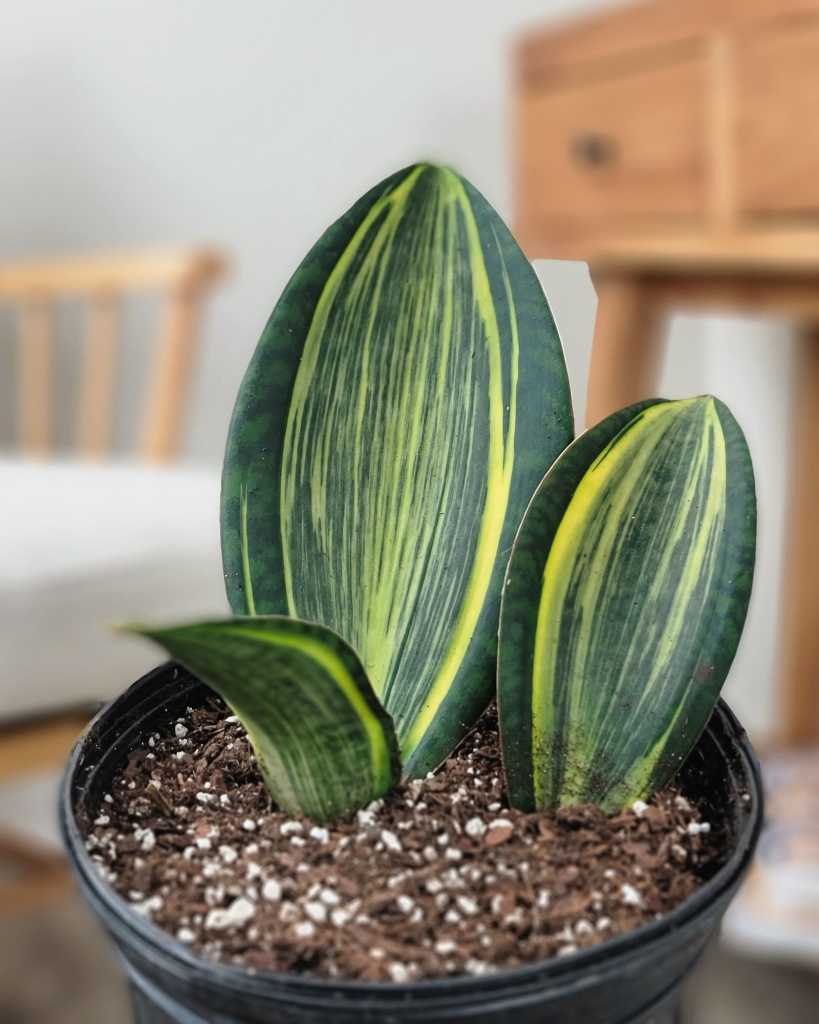
Variegated Whale Fin
Variegated Whale Fin
The Sansevieria Masoniana Variegata is one of our most requested plant and the variegated form is even more so. This beautiful form of the popular Whale Fin Sansevieria is defined by yellow stripes of varying thicknesses and intensities. The plants offered are not single rooted leaves like you usually find, but are fully rooted plants with a few leaves.
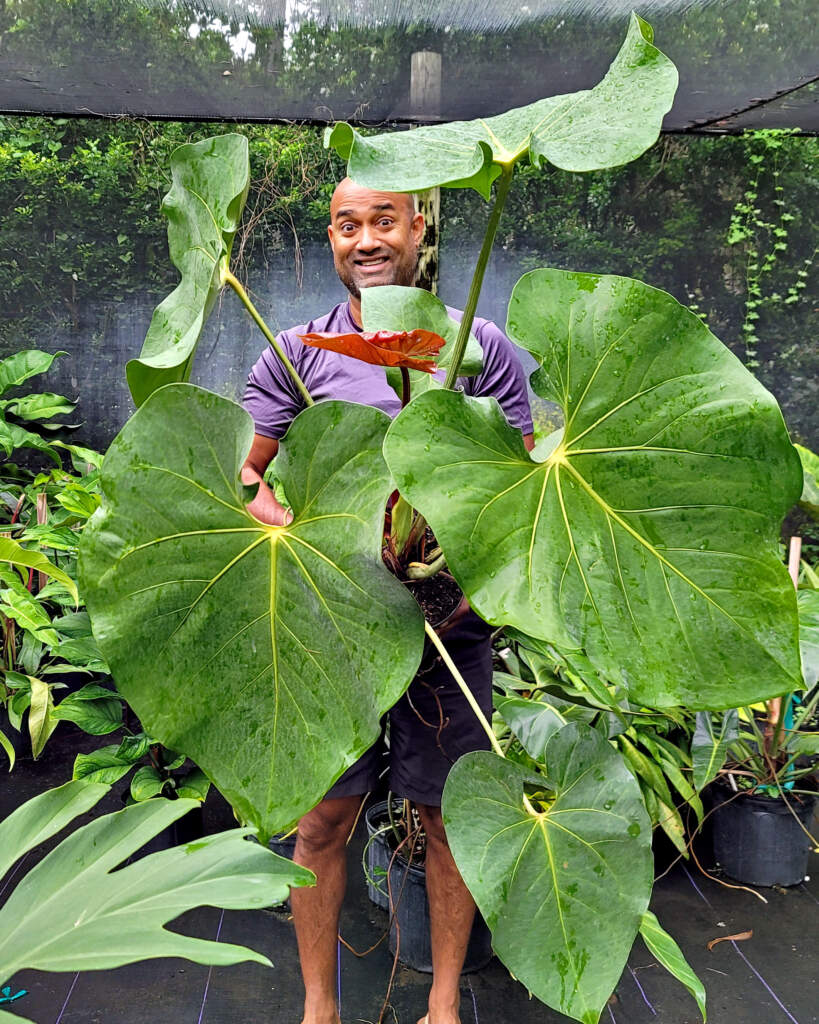
Faustino’s Giant Anthurium
Faustino’s Giant Anthurium
Faustino’s Giant is one of the largest anthuriums which has leaves that can grow to up to 4 feet long! The plant is native to Mexico and is a tough aroid that also grows well in the ground (it’s actually a great landscape plant). Tender new leaves emerge with a stunning glossy red color but become stiffer and turn matte green as they mature.
The heart-shaped leaves are incredibly stiff, with a cardboard-like texture. The Faustino’s Giant Anthurium was named in the early 1990s in honor of Spanish botanist Faustino Miranda. It also prefers high humidity, but grows fine in normal room humidity.
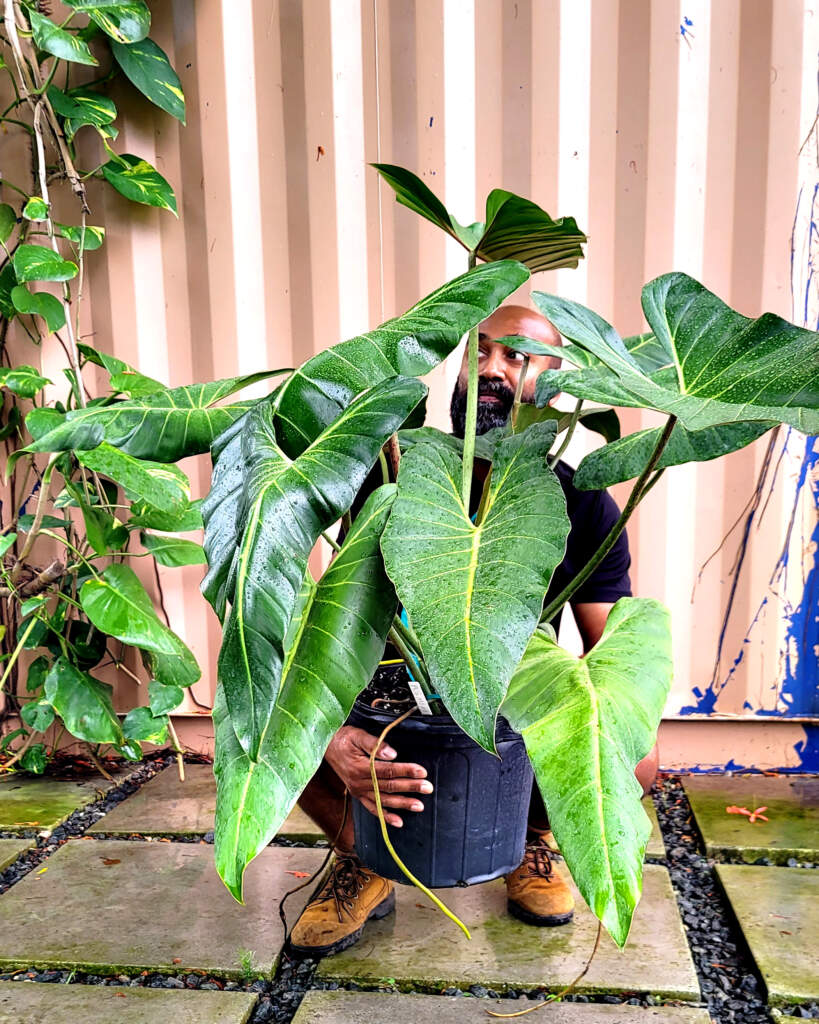
Philodendron bernardopazii
Philodendron bernardopazii
Also known as Philodendron superbum, this easy to grow philodendron is hard to find and highly sought after for its exceptional aesthetics. The elongated, glossy leaves with contrasting white veins are also beautiful underneath with red veins. The stems have pinkish hues and white streaks. Although vigorous growers outdoors, they are relatively slow growing as a houseplant.
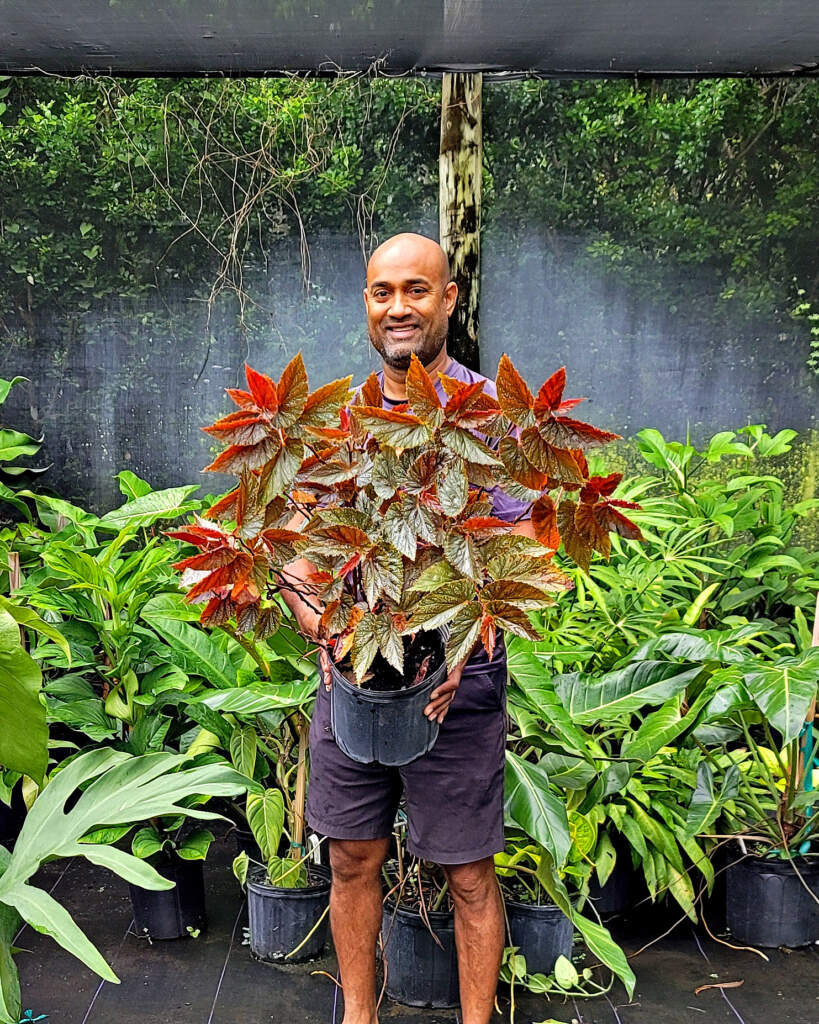
Begonia ‘Maurice Amey’
Begonia ‘Maurice Amey’
This stunning cane begonia awes with iridescent silvery-burgundy leaves dotted with silver spots. The back of the leaf is just as impressive with its radiant dark red color. Like a lot of cane begonias, the clusters of pink flowers hang from the tips of the stems. It’s a fast growing, prolific begonia which branches nicely.
The name of this vibrant and vivid begonia is an apt dedication to the late Maurice Amey, a colorful former member of the American Begonia Society.
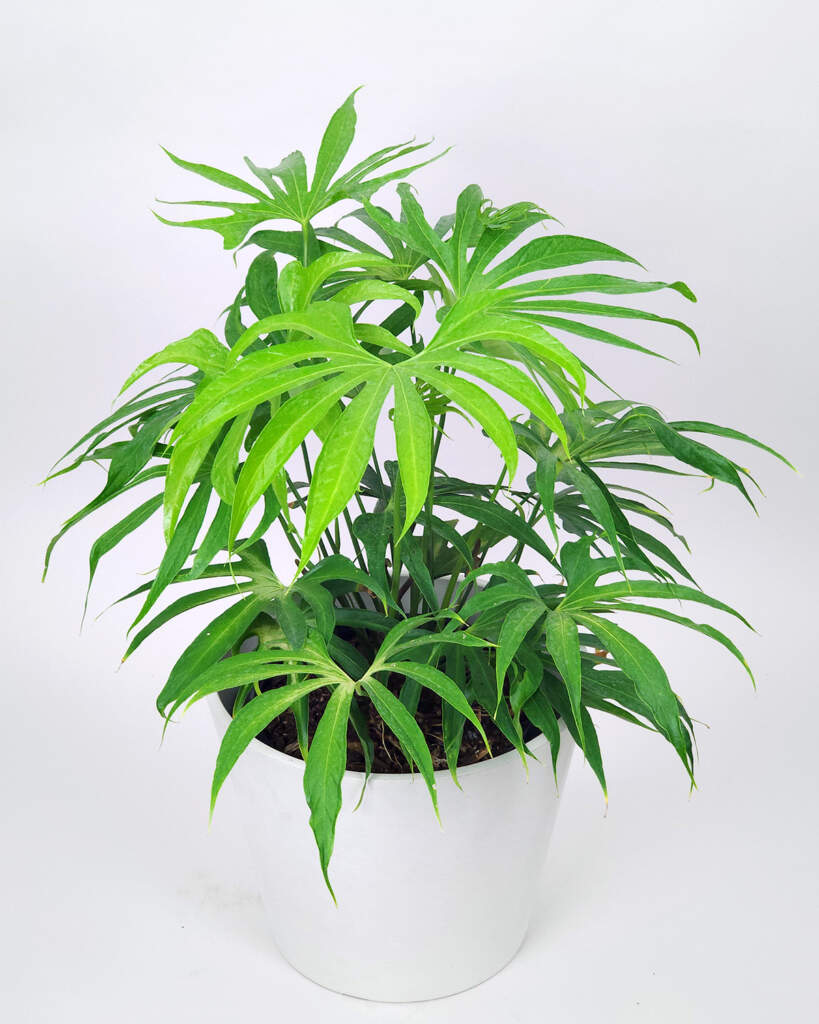
Anthurium ‘Fingers’
Anthurium pedatoradiatum ‘Fingers’
Anthurium pedatoradiatum, also known as Anthurium Fingers, is a tropical plant native to the rainforests of Central and South America. It has distinctive, finger-shaped leaves that grow to over 3 feet in height. The leaves become more palmate as they mature, producing more “fingers”. This terrestrial anthurium tolerates lower humidity than most others, making it a great houseplant. I have a limited amount of really nice, mature specimens available.
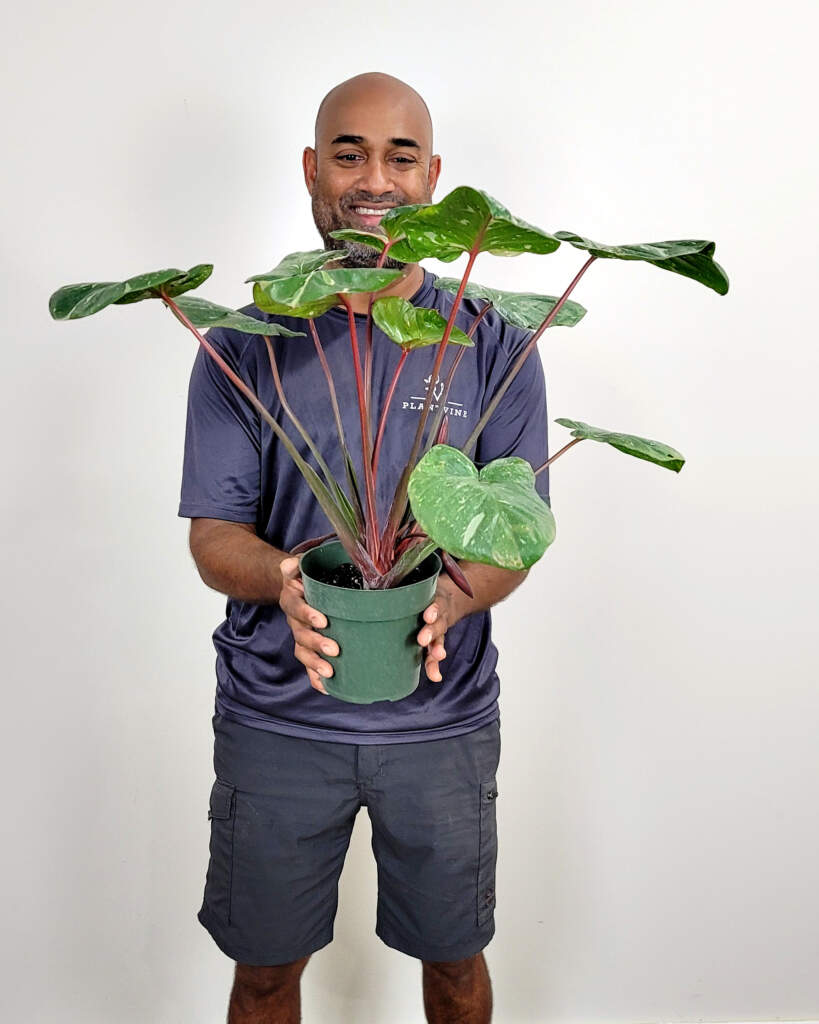
Homalomena rubescens ‘Pink Splash’
Homalomena rubescens ‘Pink Splash’
The Homalomena rubescens Pink Splash is a tropical plant with bright green leaves that are splattered with white and pink. It is a leafy herbaceous aroid with heart-shaped leaves that grow on long red petioles. The plant’s inflorescence includes a burgundy-red spathe and white spadix. The pink and white variegation are extraordinarily pretty, one of the most beautiful variegations in my opinion. It’s an easy to maintain plant so long as you don’t overwater it and plant it in well drained soil.
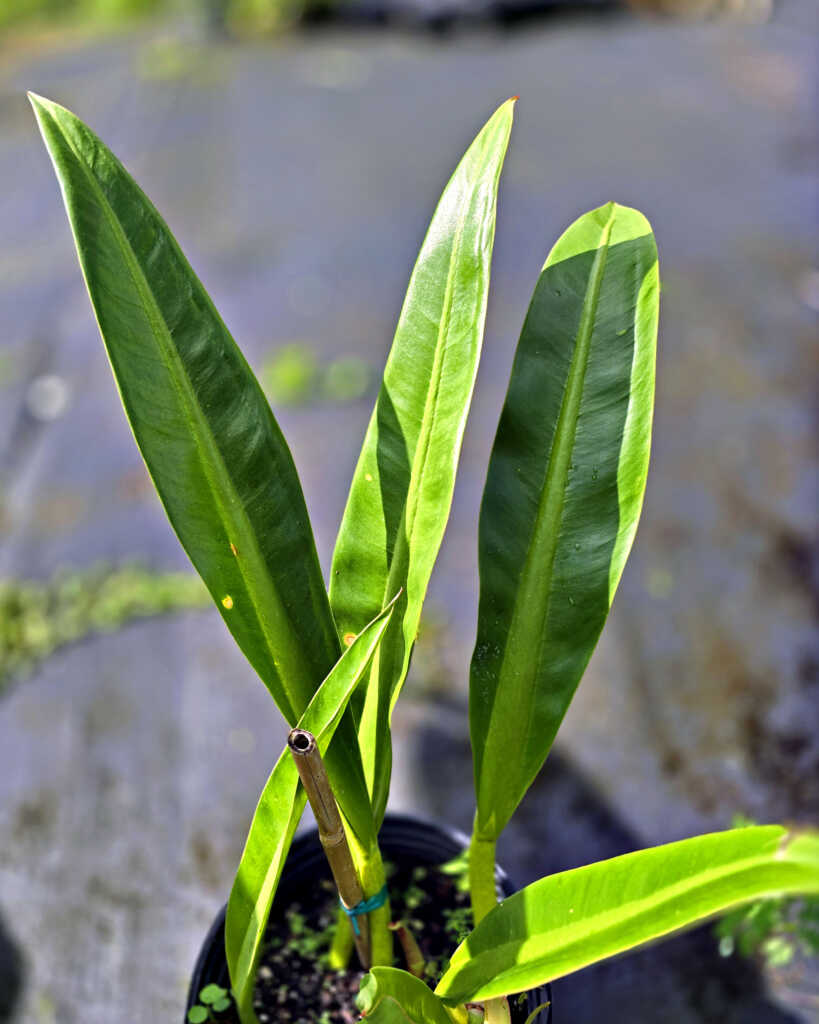
Philodendron crassinervium
Philodendron crassinervium
Philodendron crassinervium is a very rare tropical, evergreen plant with long, narrow leaves that point upwards. The leaves have a large mid-vein that is filled with red sap glands that the plant uses to store water during dry periods. The leaves are dark green and have a wavy margin. The plant is native to southeastern Brazil close to the Atlantic Ocean. It grows best in moist, shady conditions. Philodendron crassinervium is a slow climber that can grow quite tall. It can be grown on a moss pole or trellis, or in a hanging basket. It can be used as a statement piece in any room, adding a touch of tropical flair to your home décor.
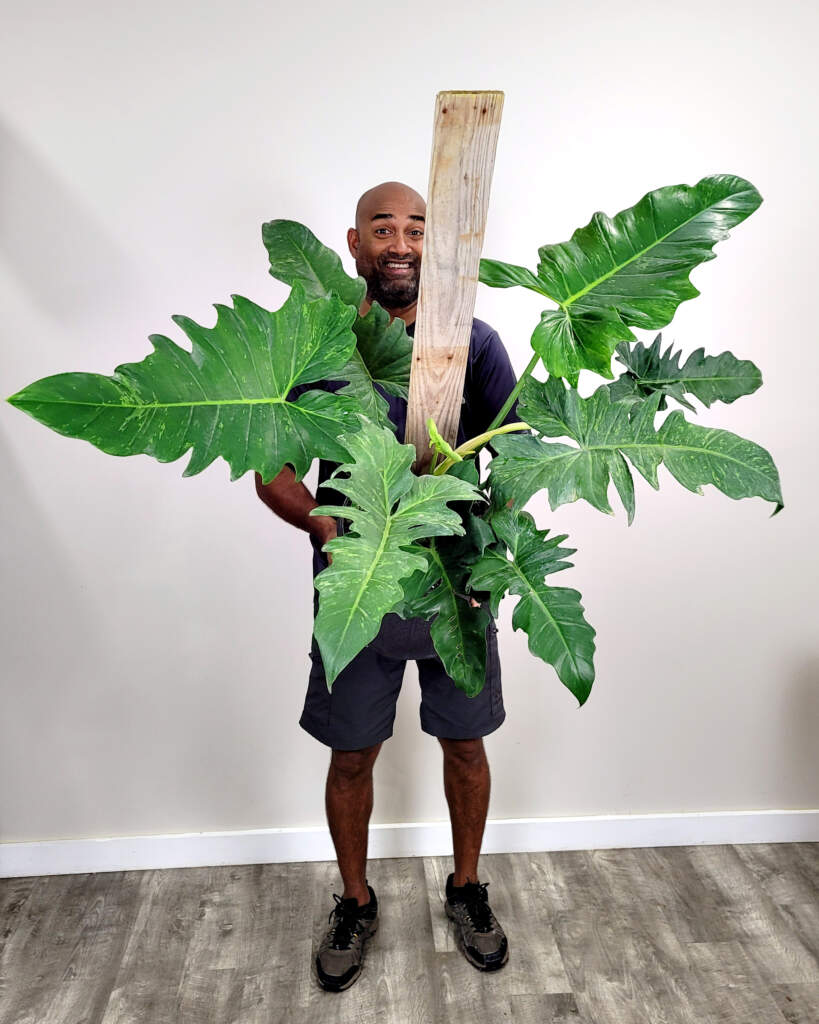
Philodendron ‘Golden Dragon’
Philodendron ‘Golden Dragon’
This rare philodendron hybrid features lovely lobed leaves covered with golden splashes. The glossy foliage resemble a dragon’s head, hence the name. New leaves usually start off without lobes and variegation, but those become more pronounced as they mature. As a low maintenance, slow climber, it would benefit from a totem pole to reach its full potential. Originating from Thailand, not much is known about who created it or which are the mother plants.
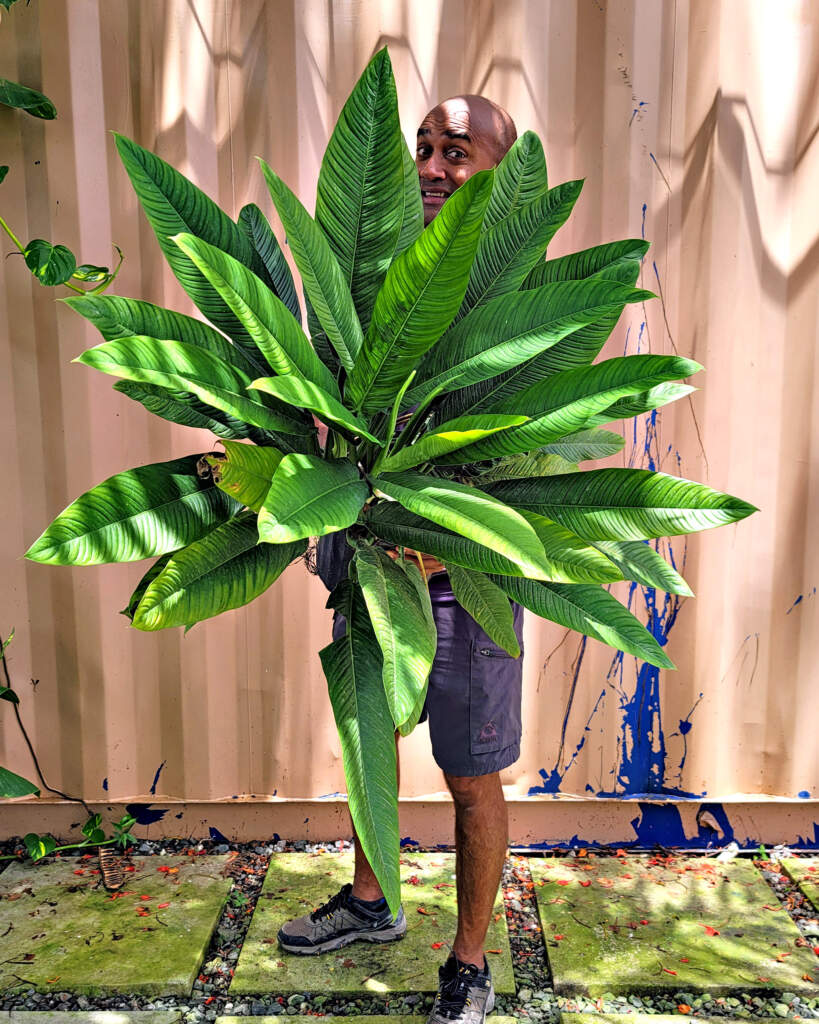
Philodendron campii ‘Lynette’
Philodendron campii ‘Lynette’
This rare aroid is by far one of the more attractive philodendron houseplants. Its lush green foliage is organized in a tight spiraling manner, giving it a beautiful, almost bird’s nest like appearance. It’s easy to grow, tolerates various light conditions (but not direct sun) and is mostly pest free. The leaves resemble spears with their pointy, elongated shape. The numerous ribs on the leaves give it a unique washboard texture, ensuring it’ll stand apart from all the plants around it.
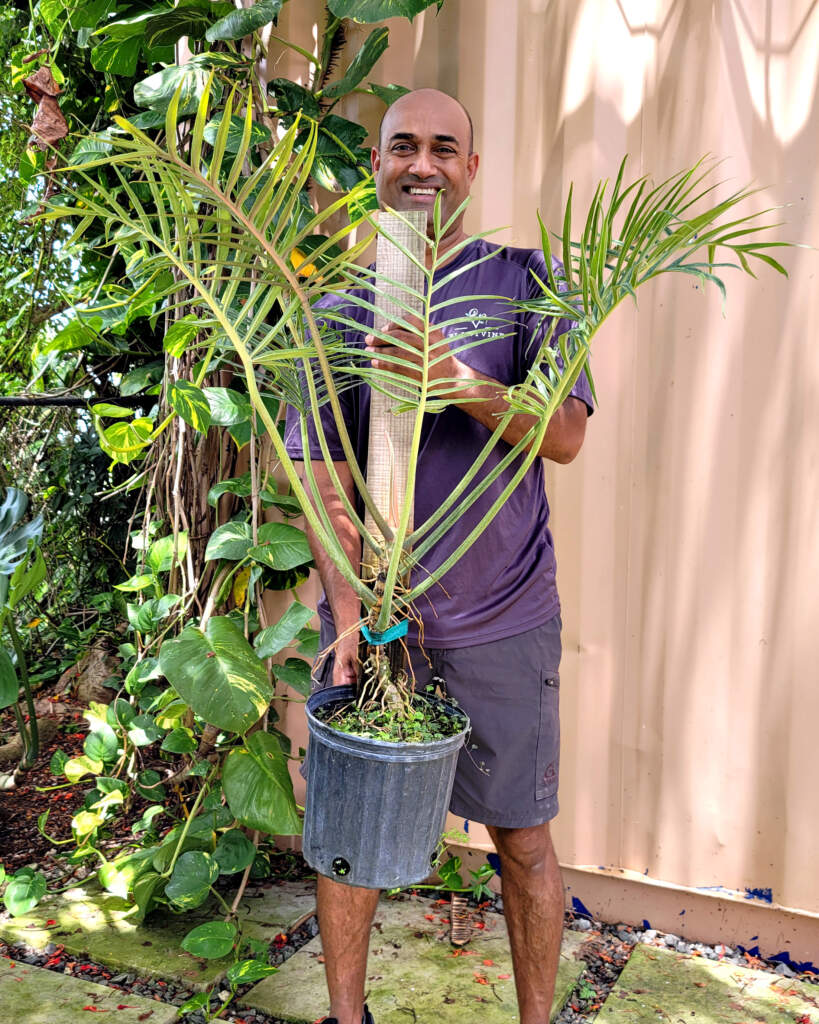
Philodendron tortum
Philodendron tortum
Tortum is a really rare and interesting philodendron with leaves that open up in a corkscrew fashion. This multi-stemmed philodendron has a bushy appearance and, like a lot of philodendrons, enjoy climbing; so it should have a totem pole or stake to attach to as it grows. The distinctive leaves resemble fish bones because of their long and thin appearance.
It tends to like more light and humidity than most philodendrons so close to a window or a well-lit area is preferred. This large specimen is already climbing up a totem.
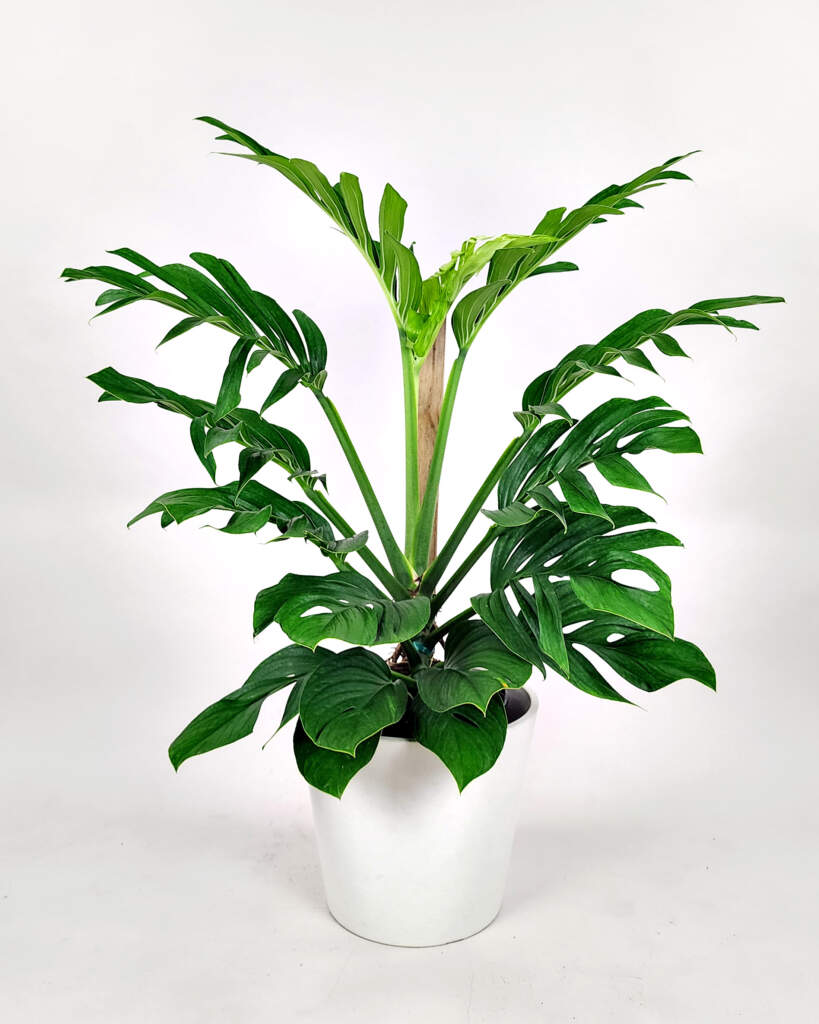
Monstera pinnatipartita
Monstera pinnatipartita
This rare plant originates from the rain forests of South America and, like the regular swiss cheese monstera, strives best with good humidity and indirect light. The leaves of this tight climber change dramatically, giving the mature plant a completely different look from juveniles. Young plants have solid leaves which split and become more fenestrated as the plant develops. Whereas the monstera deliciosa has holes in the leaves, the splits on these leaves extend all the way from the edge to the midrib. Grown indoors, a juvenile plant would probably never get leaves this large.
This is one of the most interesting looking houseplants in my opinion with its pinnate shape and cool roots. Although it’s a slow growing plant, these big specimens already have the mature leaf structure.
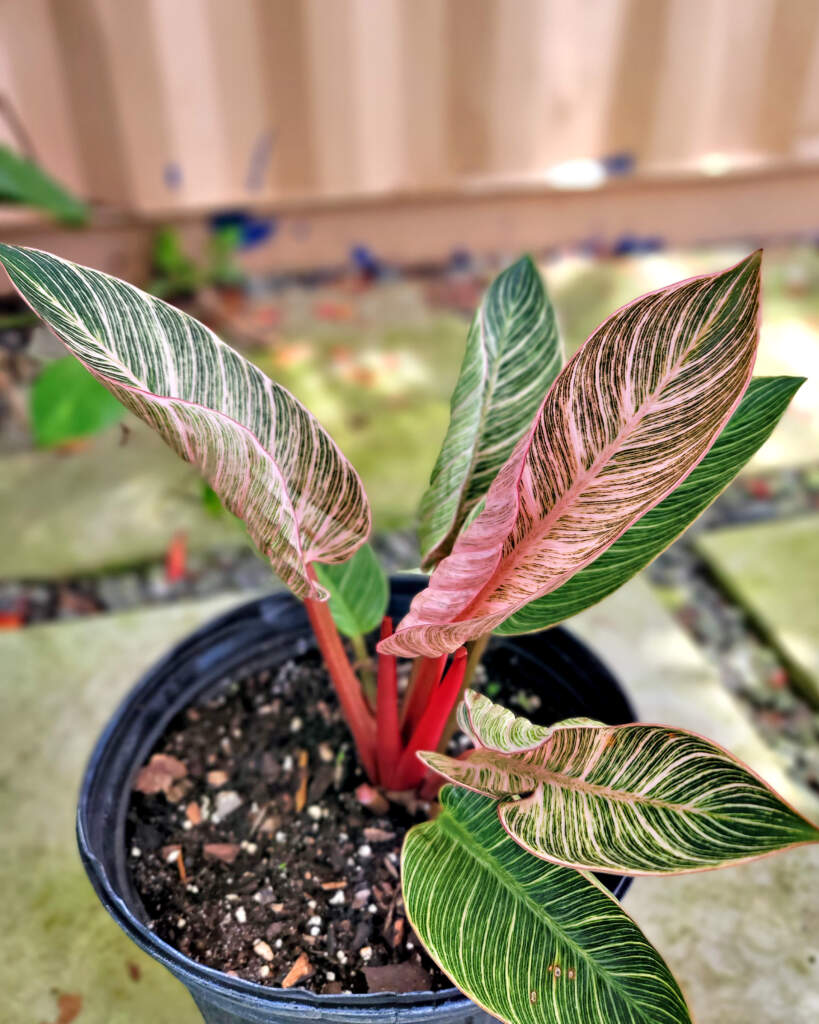
Philodendron birkin ‘Kinky Pinky’
Philodendron birkin ‘Kinky Pinky’
While walking through the Rojo Congo crop at one of my growers a couple years ago I stumbled upon these amazing plants. The regular Philodendron Birkin is a mutation of Philodendron Rojo Congo which was tissue cultured and is now mass produced. Well, in this crop of Rojo Congos I found only two of these mutations. Like Birkins, they have pretty stiped foliage; but the Kinky Pinky take it to another level with stunning pink foliage, more elongated leaves and gorgeous red stems.
The pink foliage sometimes unfurl with crinkled edges, hence the name Kinky Pinky. Over the years I’ve tried to find more of these with no luck, so I had to resort to propagating them myself by cuttings. Coming from just a couple small plants, this was a long and arduous process but I finally have a few ready to sell. I know a few people have found some in the past because I’ve seen pictures online, but I haven’t seen any for sale from anyone, anywhere in a very long time.
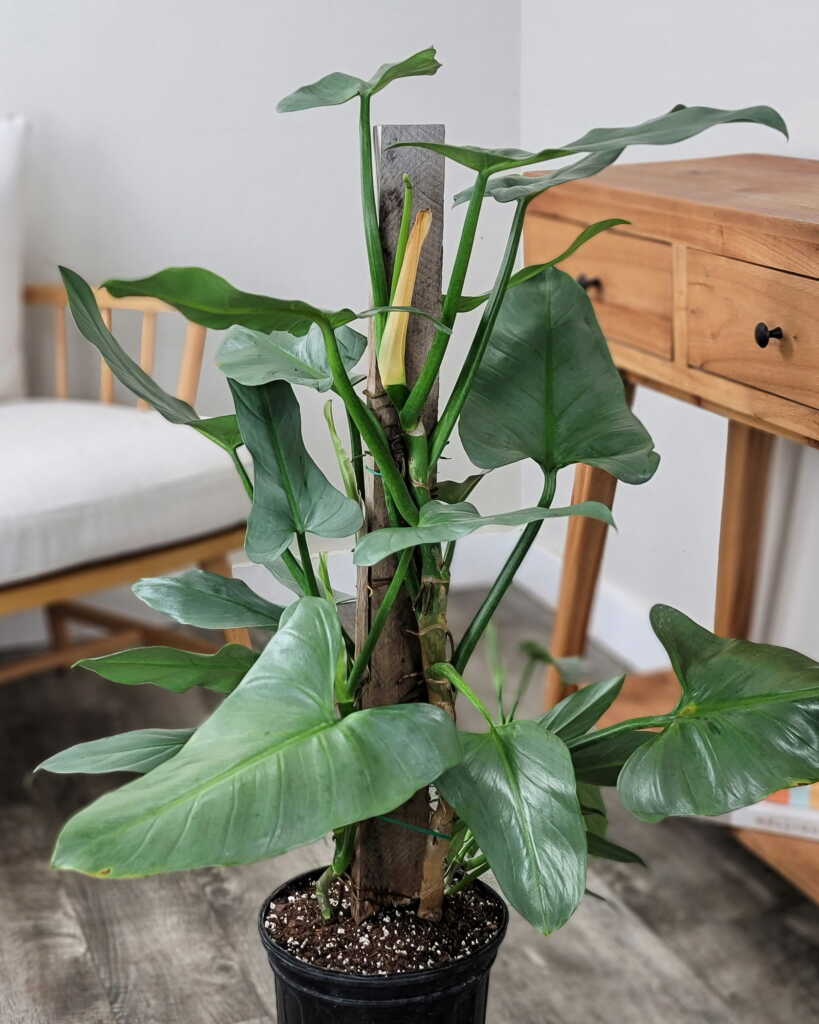
Philodendron ‘Silver Sword’
Philodendron ‘Silver Sword’
Philodendron Hastatum is an attractive vining plant with bluish-silver lance-like leaves. The foliage on young Silver Sword Philodendrons, as it is commonly called, have a more intense silver hue and sword shape than the mature ones. As the plant matures they become more arrow-head shaped and turn a greener color.
Silver Sword Philodendrons are fast growing Aroids. It’s a climbing philodendron which grows faster and develops larger leaves if it has something to climb onto such as a totem pole. This is an extra large extremely overgrown specimen with huge leaves.

Mexican Philodendron
Philodendron Mexicanum
This tri-lobed, strap leaf philodendron is a climber which grows fast. Its natural habitats are the rainforests of Mexico down to upper South America. The leaves have a distinctive deeply lobed shape and can get quite large, often up to 2 feet long, often resembling dog ears. This unusual and rare plant is a true collector’s item. I have one ginormous specimen which is almost 4ft wide!
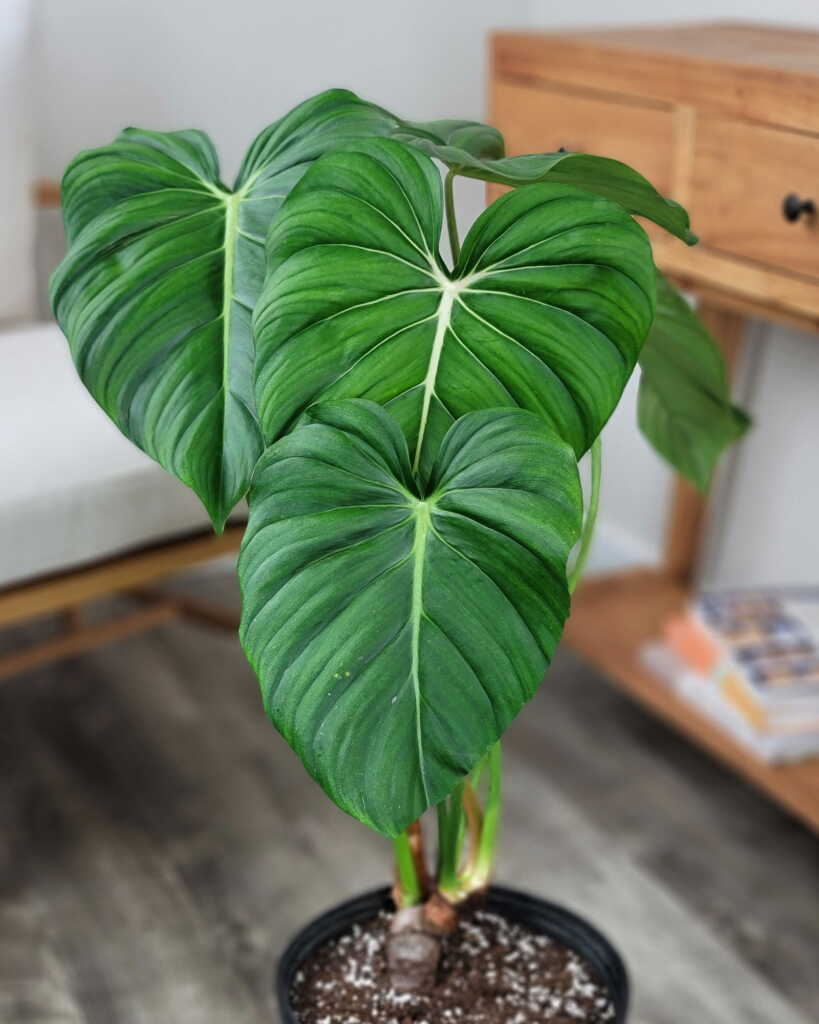
Philodendron McDowell
Philodendron McDowell
The beautifully textured dark green leaves with creamy white veins are the highlight of this Philodendron. This batch of McDowells have amazing pinkish-white veins on the new leaves. Also known as the Philodendron McDowellii (or McDowell), it’s thought to be a hybrid between the Philodendron Gloriosum and another unknown variety. Whereas the Gloriosum has a velvety surface, the McDowell is smooth and shiny. It has a vigorous growth habit and will get to over 3 feet high. I have 12 stunning, very large specimens available.

Anthurium ‘Thai Ruby’
Anthurium ‘Thai Ruby’
This EXTREMELY rare variegated anthurium hybrid from Thailand is absolutely stunning. The wide leaves of these plants can come in varying degrees of greens, whites and even reds. This particular specimen is spectacular with more variegation than I usually see, plus it’s got lots of white and cream. When you find these plants for sale they’re usually baby plants – this is a large, mature plant which will impress any rare plant collector.
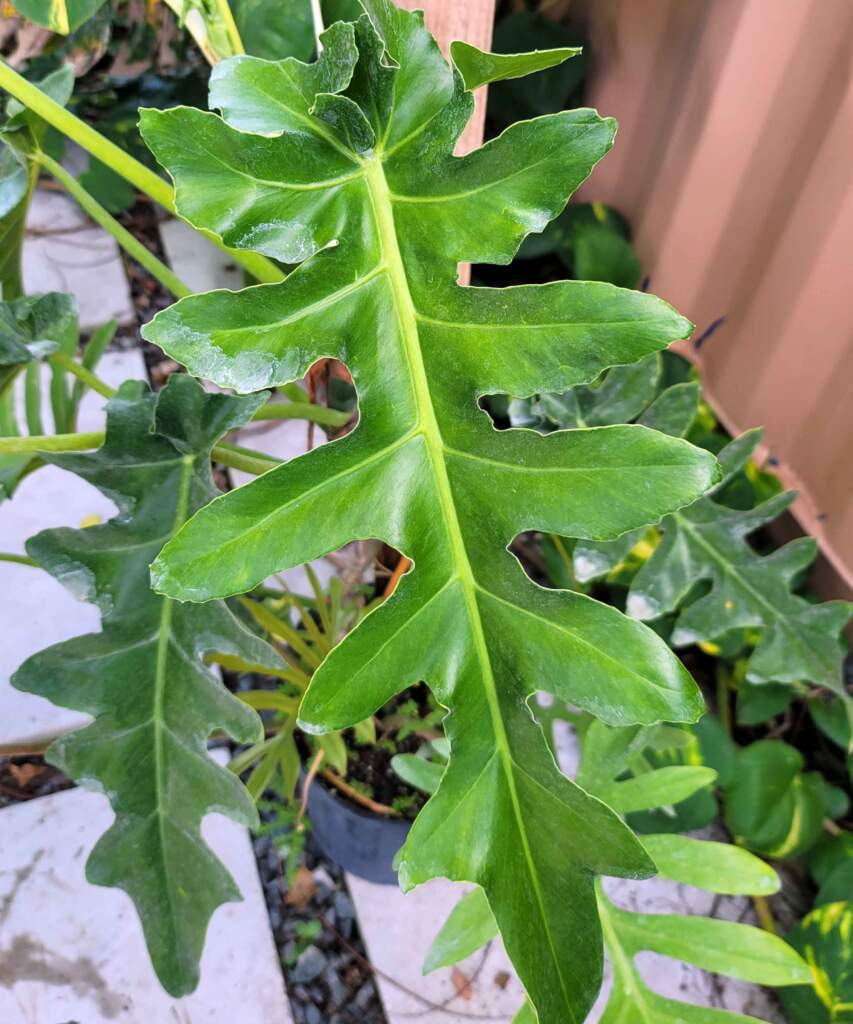
Philodendron Bob Cee
Philodendron ‘Bob Cee’
This rare hybrid by the late legendary Bob Cee is a stunning plant known for its distinctive foliage and compact growth habit. The large pinnate leaves are very long, glossy and highly segmented. They feature a beautiful blend of green and yellow tones, making it an eye-catching addition to any indoor space. Bob Cee is a relatively low-maintenance plant, thriving in moderate to bright indirect light and requiring infrequent watering. This philodendron variety is highly sought after by plant enthusiasts due to its unique shape, striking appearance and ease of care.
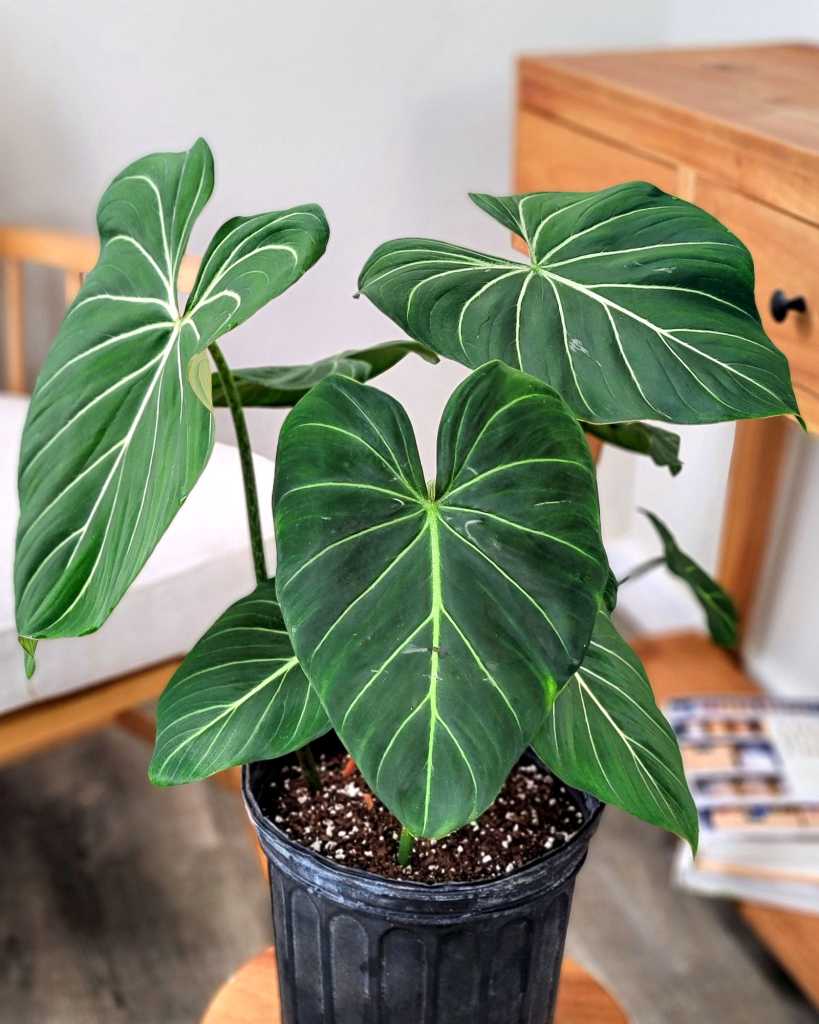
Philodendron gloriosum
Philodendron gloriosum
Unlike many other philodendrons, the Gloriosum is more terrestrial and wants to crawls along the ground rather than climb. The gorgeous heart shaped leaves are velvety green with striking white veins. Flashes of pink will occasionally show on the margins, veins and new growth. Not only is it beautiful but it’s also a low maintenance plant which is easy to maintain- just place in a spot with about 70% shade and keep the soil moist, but not drenched. The Philodendron Gloriosum is arguably one of the most striking philodendrons which adds dramatic tropical flair to any space. These particular specimens are huge with many stems which could be divided into numerous plants.
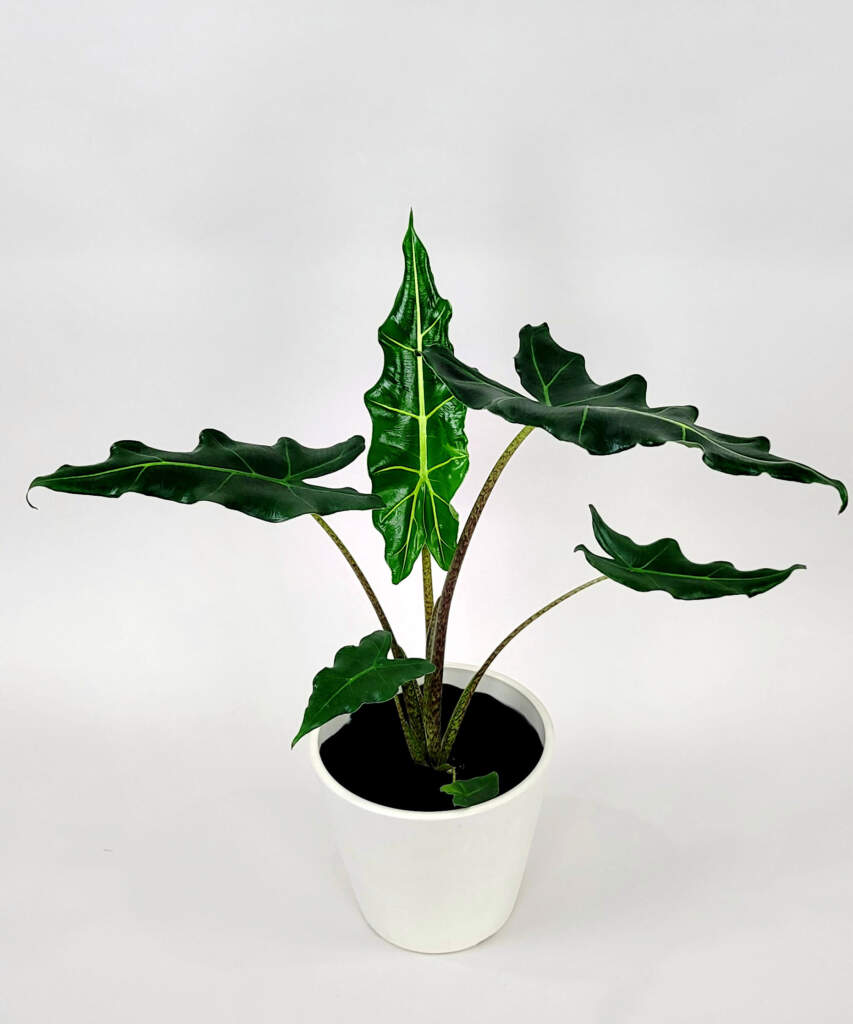
Alocasia ‘Sarian’
Alocasia ‘Sarian’
Although this striking variety of elephant ear plants is not considered too rare, it is still a sought-after alocasia because of its cool stems and leaves. The arrow-shaped leaves are dark green with whitish, highly-defined veins. The stems are beautifully spotted with dots of purple, which comes from one of the Alocasias it was hybridized from. They can grow up to 10 feet in ideal conditions but typically get to around 5 feet indoors. I’d recommend keeping it in a bright spot where the plant will have the tendency to grow a bit more compact and not as stretched out.


